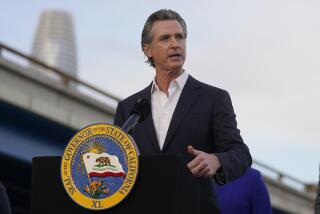Politics Dog the Oil Reserve
- Share via
STANFORD — With oil prices heading toward $50 a barrel, what would happen if the markets really blew?
Ever since the late 1970s, Washington’s answer to such an event has relied on oil stockpiled mainly by the federal government, to be released if market instability warranted it. Today, the U.S. Strategic Petroleum Reserve contains 666 million barrels -- nearly 65 days of imports -- worth nearly $30 billion at current prices. Our industrialized allies have similar stocks, India has started one and China, whose oil imports are rising rapidly, is expected to create a reserve soon. Through the International Energy Agency in Paris, the major oil importers have agreed, in principle, to coordinate their stockpiles.
Unfortunately, reserves in the United States and most democracies are nearly feckless as a policy instrument. The legislation that created the U.S. reserve gave the power to buy and sell stocks to a federal agency, now the Department of Energy, that, in effect, passes the decision on to the president. White House control automatically converts every key decision into a highly political act.
In July 2000, President Clinton’s order to transfer some strategic reserves to fill a newly created Northeast Home Heating Oil Reserve had obvious political implications for Al Gore’s presidential bid. In 1996, Congress required the sale of more than $220 million of stockpiled oil to help pay down the budget deficit, another political move, though one that, in hindsight, looked wise when oil prices tanked two years later.
The uncertainty of reliable production in Russia and Iraq, coupled with the general threat of new terrorist attacks, makes for many worrisome scenarios. But a cloud of political suspicion would hang over any management decision. If President Bush released stockpiled oil to stabilize prices in an election year, no matter how justified his action, he surely would be accused of political pandering. And if he rightly refused to release oil because speculative trading doesn’t meet the standard of “severe energy supply interruption,” as called for in the 1975 legislation setting up the Strategic Petroleum Reserve, would he face charges that he was rewarding his oil buddies with record profits?
One way to take the politics out of governing the Strategic Petroleum Reserve would be to mechanize decision-making, such as by setting a price trigger for sales and fills. President Reagan’s Council of Economic Advisors, among others, considered this option and wisely demurred. In the 1980s, the international spot market for oil was not fully developed; prices were mainly driven by opaque long-term contracts, not market dynamics. Price triggers act similarly to price controls, increasing the risk of creating true scarcities in oil supply. Such automatic triggers would have smoothed small gyrations in the oil market but failed when most needed to dampen large price swings.
There’s a better way: independent management of the strategic reserve. In contrast to an automatic mechanism, an independent authority would be able to detect subtle economic and political shifts that determine our true vulnerability to oil shocks. More important, such an authority would depoliticize Strategic Petroleum Reserve decision-making, which would enable us to use the stockpile for its originally intended purpose of providing a credible bulwark against the most severe chaos in oil markets.
The president could create an independent board to manage the reserve within existing legislation, but that would not completely remove a political taint. New legislation would better accomplish the job. Congress and the president should look to the Federal Reserve as a model. The Strategic Petroleum Reserve needs its own resources, with politicians supplying broad guidelines for action and periodic review rather than direct control. Such a change would not only affect the United States but would also require remaking the International Energy Agency into something closer to a central bankers’ forum.
New management for America’s oil reserve would spark new thinking about the optimal size and operation of strategic stocks. Until now, most public debate has focused on the reserve’s size. The International Energy Agency suggests that its member countries keep a petroleum stockpile roughly equivalent to 90 days of domestic consumption. In truth, the optimal size of strategic reserves is not a single quantity but depends on political and economic conditions. A competent independent authority would make it possible to carry a smaller stockpile -- at lower cost. Because today’s oil prices are formed in highly liquid markets, the standard of “severe supply interruption” is largely meaningless. The better standard is our willingness to absorb price shocks. For that there is no simple answer, yet independent economic authorities can make the wisest choices.
More than 30 years after our first oil shock, the Strategic Petroleum Reserve still wears polyester and bell-bottoms. A dose of market reform and political independence can bring its fashion up to date and create a truly useful tool for protecting the U.S. economy.
More to Read
Get the L.A. Times Politics newsletter
Deeply reported insights into legislation, politics and policy from Sacramento, Washington and beyond. In your inbox three times per week.
You may occasionally receive promotional content from the Los Angeles Times.










